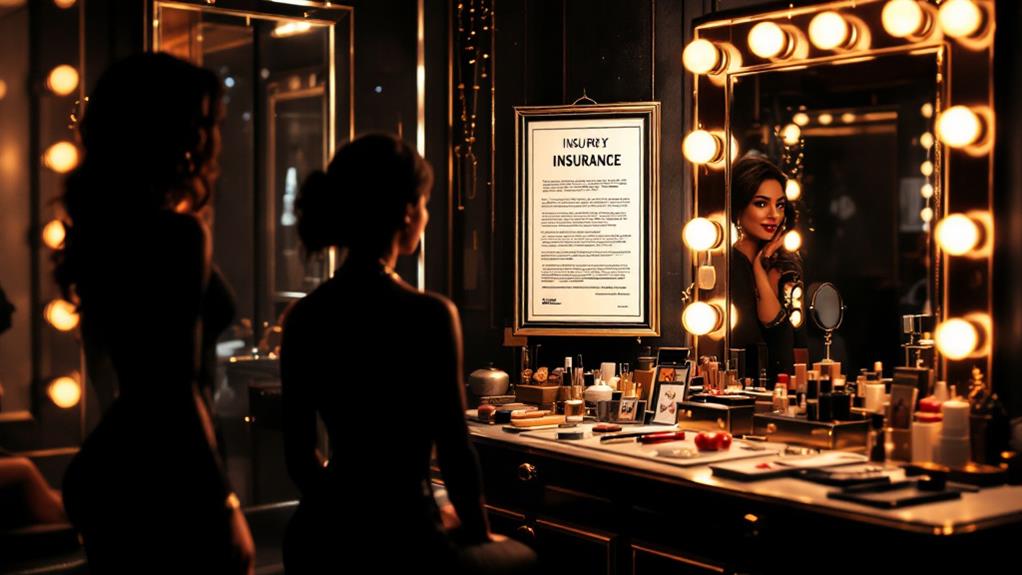Celebrities Who Insured Their Body Parts: The Unusual Side of Fame

You might be surprised to learn that celebrities often insure their body parts to protect their careers and improve their brand. It's all about safeguarding their most valuable assets. Mariah Carey secured her vocal cords and legs with whopping valuations. J-Lo insured her famous buttocks for a staggering amount. These policies aren't just vanity—they're smart financial strategies in an unpredictable industry. Lloyds of London, a top player, handles many of these unique insurance requests. These extraordinary measures blend income protection with personal branding, underscoring how intrinsic personal attributes are to fame. Uncover what drives these insurance choices.
The Rationale of Body Part Insurance
In the world of entertainment, where appearances and abilities often define success, insuring body parts has become a critical safety net for many celebrities. You might wonder why this is vital, but when your career hinges on specific physical attributes, it makes perfect sense. Celebrities whose livelihoods depend on their unique talents, like Mariah Carey, see the potential risks and financial implications if those talents were compromised. Carey's decision to insure her vocal cords and legs for a whopping $70 million highlights how valuable these body parts are to her career.
Historical Context and Evolution
The concept of insuring body parts traces back to the 1920s, when comedian Ben Turpin set a quirky precedent by insuring his cross-eyed gaze. This unusual step paved the way for body part insurance in the entertainment industry, where physical attributes are seen as valuable assets. As the industry evolved, many celebrities recognized the financial implications of protecting their distinctive features, leading to a broader acceptance of such policies.
By the late 20th century, insuring body parts became common among high-profile figures. Betty Grable, for instance, insured her legs for $34,000, popularizing this trend. This move not only highlighted the importance of specific attributes but also emphasized personal branding and marketability. The practice has since become a cultural norm, showcasing how celebrities perceive their bodies as crucial elements of their careers.
Today, the trend has escalated with modern stars like Mariah Carey reportedly insuring her legs for $1 billion. This highlights the immense financial implications of potential career-impacting injuries. In the entertainment world, body part insurance is now a key element of celebrity culture, reflecting changing attitudes toward:
- Personal branding
- Marketability
- Financial protection
- Unique features
These insurance policies underscore the ongoing evolution of how celebrities safeguard their valuable assets.
High-Value Insurance Examples

Celebrities often take extraordinary measures to protect their most valuable assets, and high-value insurance policies are at the forefront of these efforts. Take Mariah Carey, who has insured her vocal cords for $35 million and her legs for a staggering $1 billion. These insured body parts emphasize the significance of her vocal talent and stage presence to her career. You might be surprised to learn that even a smile can be worth millions. Julia Roberts, known for her iconic smile, has it insured for $30 million. This Celebrity Insurance highlights the substantial role her smile plays in her acting success.
Sports stars are not left behind. Cristiano Ronaldo, for instance, has insured his legs for approximately $144 million. This reflects the vital role they play in his football career. Likewise, David Beckham's $195 million insurance policy, with $70 million specifically for his legs, underscores the importance of his physical attributes. In the music industry, Bruce Springsteen has insured his vocal cords for $6 million, demonstrating the essential nature of his voice to his legacy. Many of these high-value insurance policies are underwritten by Lloyds of London, a name synonymous with Celebrity Insurance.
Unique Insured Body Parts
Every so often, you'll come across celebrities who take insurance to intriguing levels by covering their more unconventional body parts. These unique insured body parts not only highlight the creativity of the celebrities but also their understanding of how specific features contribute to their public persona. For instance, Jennifer Lopez famously insured her buttocks for a staggering $300 million. This decision underscores her confidence in her body image and its significant role in her brand identity.
Dolly Parton opted to insure her breasts for $600,000, a move that showcases both her humor and her iconic status in the entertainment industry. Meanwhile, Miley Cyrus took it a step further by insuring her tongue for $1 million, tying this choice to her bold public persona and artistic expression.
Keith Richards, the legendary Rolling Stones guitarist, recognized the importance of his hands, insuring them for $1.6 million. His decision reflects their essential role in his musical performances. Ultimately, Daniel Craig took a thorough approach, insuring his entire body for $9.5 million while performing his own stunts in James Bond films.
- Jennifer Lopez: Insured her buttocks
- Dolly Parton: Insured her breasts
- Miley Cyrus: Insured her tongue
- Keith Richards: Insured his hands
Celebrity Marketing Strategy

Leveraging body part insurance as a marketing strategy, celebrities improve their public image while showcasing the unique value of their physical attributes. By insuring body parts, they highlight what makes them stand out in the entertainment industry, turning their unique traits into a brand asset. This practice isn't just about protection; it's a clever way to increase marketability. When A-listers like Jennifer Lopez or Mariah Carey insure their assets for millions, it underscores their value and attracts media attention.
You might wonder how this benefits them beyond public perception. Well, it ties directly into endorsement deals. Companies often fund these high-value insurance policies, ensuring that celebrities have a financial safety net against potential income loss due to injuries. This strategy aligns the star's unique physical attributes with the brand's identity, creating a symbiotic relationship.
Moreover, the cultural phenomenon of insured body parts, especially with high-profile policies at Lloyds of London, reinforces the importance of physical appearance in celebrity culture. This attention not only elevates the celebrity's profile but also keeps them relevant in a fast-paced industry. Ultimately, it's a savvy way to maintain their status and continue capitalizing on their fame.
Lloyds of London's Role
In the domain of insuring celebrity body parts, Lloyds of London leads the way with its expertise in unique and high-value insurance requests. As the go-to market for celebrity body part insurance, they've built a reputation for handling the unconventional with remarkable finesse. Celebrities flock to Lloyds of London for their extensive experience, ensuring that their valuable assets receive the protection they deserve.
Notable policies facilitated by Lloyds of London include:
- Mariah Carey's vocal cords: Insured for $35 million, reflecting their immense value to her career.
- Cristiano Ronaldo's legs: Valued at a staggering $144 million, safeguarding his vital tools for success on the pitch.
- Betty Grable's legs: Dating back to a $34,000 policy, showcasing Lloyds' long-standing history in this niche.
- Compensation for lost revenue: Ensuring celebrities can claim financial support for injuries impacting their earnings.
With Lloyds of London's role in the financial management of celebrity risks, public figures can focus on their careers with peace of mind. This institution doesn't just offer insurance; it provides a lifeline, allowing stars to claim compensation for lost revenue and medical expenses tied to potential injuries.
Financial Implications

Body part insurance isn't just a quirky celebrity trend; it's a serious financial strategy. Celebrities often take out hefty insurance policies to protect the financial value of their careers. For instance, David Beckham insured his entire body for $195 million. This immense policy reflects not just his marketability but also serves as a safeguard against career-threatening injuries. Such strategies are vital for someone whose physicality is central to their profession.
Similarly, Mariah Carey's $70 million coverage for her vocal cords and legs underscores the substantial financial implications of safeguarding assets that are the backbone of her profession. These policies aren't just about vanity; they're about securing financial protection against potential career losses.
Unique insurance choices, like Julia Roberts having her smile insured for $30 million, highlight the intersection of personal brand value and financial security. These decisions demonstrate how celebrities assign financial value to their distinct attributes, guaranteeing they remain protected.
Cristiano Ronaldo's $144 million leg insurance further emphasizes how athletes protect themselves against unforeseen setbacks. By insuring valuable body parts, celebrities assure that their ongoing income potential remains intact, no matter what challenges they might face.
The Influence of Fame
While body part insurance is a strategic financial move for celebrities, it's also a demonstration of the powerful influence of fame. When you think about it, the practice reveals how celebrity status enhances physical attributes to extraordinary value. Mariah Carey, for instance, has insured her vocal cords and legs for a whopping $70 million. This reflects not only her remarkable talent but also how fame translates into crucial financial protection.
For David Beckham, insuring his legs for $195 million highlights the immense financial stakes tied to his athletic prowess. Injuries to such insured body parts could jeopardize careers and lucrative endorsements, emphasizing the necessity of a million policy. The Gillettes Venus Breeze Celebrity ads further underscore how marketability is intertwined with personal brand value.
Consider the following:
- Mariah Carey's vocal cords and legs insurance demonstrates how fame secures financial protection for talents.
- David Beckham's insured legs highlight the intersection of celebrity status and financial stakes.
- Jennifer Lopez's $300 million policy on her buttocks showcases body part insurance's role in public image.
- The fusion of fame with marketability and financial protection is evident in these insurance choices.
Ultimately, these policies reflect how fame shapes financial and public personas.
Trends in Celebrity Insurance

With time, the trend of celebrities insuring their body parts has surged, highlighting the intersection of income protection and personal branding. Celebrities like Mariah Carey, who insured her vocal cords and legs for $70 million, are at the forefront of this movement. Body part insurance isn't just about safeguarding against potential loss of income; it's also a strategic marketing tool. High-profile figures use it to improve their public image, as these policies often attract media attention, elevating their brand value.
Lloyds of London stands as the leading market for such insurance, catering to unique requests and highlighting the financial implications of celebrity body parts. Bruce Springsteen's vocal cords, insured for $6 million, and Cristiano Ronaldo's legs, valued at $144 million, underscore the high financial stakes involved. These policies reflect how critical these body parts are to their careers, offering peace of mind and financial security.
Dating back to the 1920s with Betty Grable's legs, this practice has evolved but continues to serve the same purpose: protecting the assets that make these celebrities unique and valuable. For them, it's not just insurance—it's an investment in their future.




